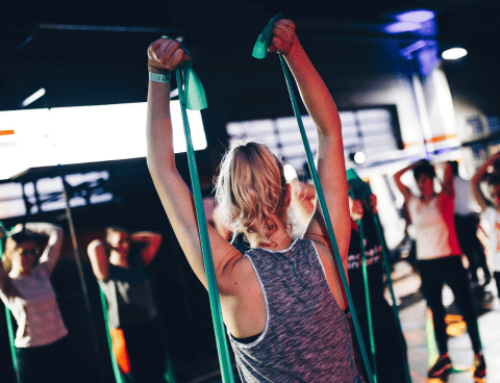Confuse Your Muscles With New Rep Techniques
If you’ve spent any time in the weight room trying to build muscle, you’ve probably discovered that doing the same reps of the same exercises during every workout grows tedious. If you’re not energized for your workouts, you’ll stop pushing yourself, and muscle gains will start to plateau. If you’ve begun to fall into a rut, stimulate your mind and body again with a few new rep techniques.
If you try out a few of these techniques, each workout can become a creative adventure. Creativity not only prevents boredom, it also keeps your muscles from adapting to your workout. You can get more out of your workouts by periodically substituting one of these variations for standard full-range reps for most bodyweight and resistance strength exercises.
11/4 Reps
For this variation, you’ll complete three quarters of a move, go back to halfway and then finish it.
Example: Squat
- Use weight at 70 percent of one-rep max
- Slowly descend until thighs are parallel to floor
- Pause slightly, with no bouncing, and slowly ascend quarter of way
- Return to bottom position
- Pause, then ascend to starting position
Sets/Reps: 2×8-10
21s
This variation is ideal for bodyweight exercises. You’ll do seven partial-range reps from the top of the motion, seven partial-range reps from the bottom of the motion, and seven full-range reps—for a total set of 21.
Example: Pull-Up
- Complete seven partial Pull-Ups, only going a quarter of way up each time
- Pull up to top of bar; do seven partial Pull-Ups, lowering only a quarter of way each time
- Complete seven full-range reps at top of bar
Sets/Reps: 2×21, with 60 seconds rest
Super Slow Reps
Complete full-range reps, spending 10 seconds on the raising motion and five seconds on the lowering motion.
Example: Standing Overhead Press
- Load bar with 60 percent of one-rep max; rest it on front of shoulders
- Raise bar for 10-second count until arms are nearly fully extended overhead
- Keeping constant tension, with no bouncing or pausing, lower bar back toward shoulder for five-second count
- Repeat without pausing at bottom
Sets/Reps: 2×4-8
Partial Reps
For partial reps, use moderately heavy weights and only press or pull through the last few inches before completing a lift. Power racks and Smith machines are perfect for partial lifts since they allow you to use pins to set the bar for the last few inches of the lift. Since partial reps are easier on the joints than full-range reps, they can be done at quick speeds and high reps.
Example: Bench Press
- Load bar with 80 percent of one-rep max and slide portable bench under rack
- Set pins two to three inches before your arms fully lock out at top of movement
- Quickly complete high number of Bench Press reps
Sets/Reps: 2×20-30, with one to two minutes rest
Photo: bodybuilding.com
Jim Carpentier is a certified strength and conditioning specialist, a New Jersey-licensed massage therapist and a health/fitness writer. He currently serves as associate health and wellness director at the Greater Morristown YMCA in Cedar Knolls, N.J.
RECOMMENDED FOR YOU
MOST POPULAR
Confuse Your Muscles With New Rep Techniques
If you’ve spent any time in the weight room trying to build muscle, you’ve probably discovered that doing the same reps of the same exercises during every workout grows tedious. If you’re not energized for your workouts, you’ll stop pushing yourself, and muscle gains will start to plateau. If you’ve begun to fall into a rut, stimulate your mind and body again with a few new rep techniques.
If you try out a few of these techniques, each workout can become a creative adventure. Creativity not only prevents boredom, it also keeps your muscles from adapting to your workout. You can get more out of your workouts by periodically substituting one of these variations for standard full-range reps for most bodyweight and resistance strength exercises.
11/4 Reps
For this variation, you’ll complete three quarters of a move, go back to halfway and then finish it.
Example: Squat
- Use weight at 70 percent of one-rep max
- Slowly descend until thighs are parallel to floor
- Pause slightly, with no bouncing, and slowly ascend quarter of way
- Return to bottom position
- Pause, then ascend to starting position
Sets/Reps: 2×8-10
21s
This variation is ideal for bodyweight exercises. You’ll do seven partial-range reps from the top of the motion, seven partial-range reps from the bottom of the motion, and seven full-range reps—for a total set of 21.
Example: Pull-Up
- Complete seven partial Pull-Ups, only going a quarter of way up each time
- Pull up to top of bar; do seven partial Pull-Ups, lowering only a quarter of way each time
- Complete seven full-range reps at top of bar
Sets/Reps: 2×21, with 60 seconds rest
Super Slow Reps
Complete full-range reps, spending 10 seconds on the raising motion and five seconds on the lowering motion.
Example: Standing Overhead Press
- Load bar with 60 percent of one-rep max; rest it on front of shoulders
- Raise bar for 10-second count until arms are nearly fully extended overhead
- Keeping constant tension, with no bouncing or pausing, lower bar back toward shoulder for five-second count
- Repeat without pausing at bottom
Sets/Reps: 2×4-8
Partial Reps
For partial reps, use moderately heavy weights and only press or pull through the last few inches before completing a lift. Power racks and Smith machines are perfect for partial lifts since they allow you to use pins to set the bar for the last few inches of the lift. Since partial reps are easier on the joints than full-range reps, they can be done at quick speeds and high reps.
Example: Bench Press
- Load bar with 80 percent of one-rep max and slide portable bench under rack
- Set pins two to three inches before your arms fully lock out at top of movement
- Quickly complete high number of Bench Press reps
Sets/Reps: 2×20-30, with one to two minutes rest
Photo: bodybuilding.com
Jim Carpentier is a certified strength and conditioning specialist, a New Jersey-licensed massage therapist and a health/fitness writer. He currently serves as associate health and wellness director at the Greater Morristown YMCA in Cedar Knolls, N.J.












